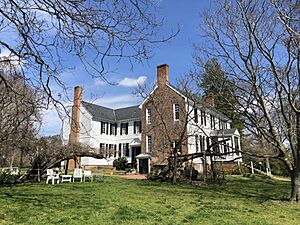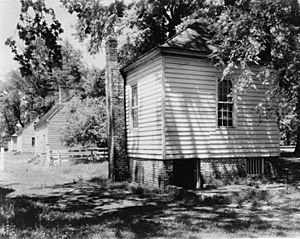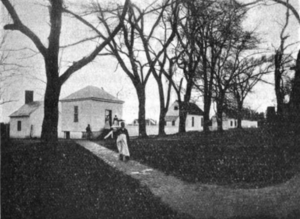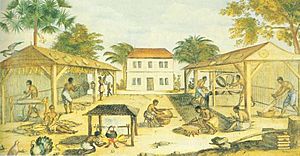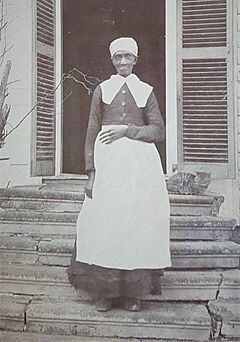Tuckahoe (plantation) facts for kids
|
Historic Tuckahoe Plantation
|
|
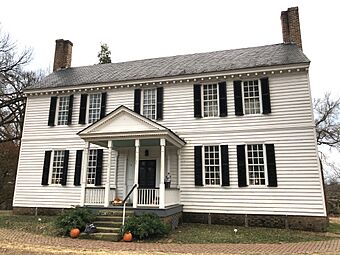
Tuckahoe's northern wing
|
|
| Location | SE of Manakin near jct. of Rtes. 650 and 647, near Manakin, Virginia |
|---|---|
| Area | 568 acres (230 ha) |
| Built | 1732 |
| Architect | William Randolph |
| Architectural style | Georgian |
| NRHP reference No. | 68000049 |
Quick facts for kids Significant dates |
|
| Added to NRHP | November 22, 1968 |
| Designated NHLD | August 11, 1969 |
Tuckahoe, also known as Tuckahoe Plantation, is a very old and important house located in Tuckahoe, Virginia. It sits on the border of Goochland and Henrico counties. This historic home was built in the early 1700s. It is a great example of a colonial plantation house. It's also special because it's a "prodigy house," meaning it was a grand and impressive home for its time. Thomas Jefferson, who later became a U.S. President, spent part of his childhood here. Tuckahoe was recognized as a National Historic Landmark in 1969.
Contents
A Look at Tuckahoe's Past
Early Settlers and Builders
Thomas Randolph first settled at Tuckahoe around 1714. He helped build the local church, Dover Parish, in the early 1720s. When he arrived, he brought many enslaved people with him. These individuals were inherited from his father's estate and formed the workforce for the plantation.
Thomas's son, William Randolph III, built the main mansion we see today. He and his wife, Maria Judith Page, had three children. After his wife died in 1744, William passed away the next year. In his will, he asked his friend Peter Jefferson to come to Tuckahoe. Peter Jefferson was the father of young Thomas Jefferson.
Thomas Jefferson's Childhood Home
Peter Jefferson and his wife, Jane Randolph Jefferson, moved from their home in Charlottesville to Tuckahoe Plantation. They brought their three daughters and two-year-old son, Thomas. The Jefferson and Randolph children lived together in the unique H-shaped house until 1752. Peter Jefferson managed the plantation and its workers. He continued to have a connection to the estate even after moving back to his own plantation, Shadwell.
Thomas Jefferson lived at Tuckahoe for seven years of his childhood. It was here that he began to form his ideas about slavery. He later wrote about how the relationship between enslavers and enslaved people was often harsh. He noted that children saw this and learned from it.
The whole commerce between master and slave is a perpetual exercise of the most boisterous passions, the most unremitting despotism on the one part, and degrading submissions on the other. Our children see this, and learn to imitate it…
Later Owners and Changes
Thomas Mann Randolph Sr., the son of William Randolph III, had many children. After his first wife died, he remarried. His new wife, Gabriella Harvie, made some changes to Tuckahoe. She had the "White Parlor" painted.
The eldest son, also named Thomas Mann Randolph Jr., became an important statesman. He was governor of Virginia from 1819 to 1822. Another son, Thomas Mann Randolph Jr./III, inherited Tuckahoe but later sold it because of debts in 1830.
Over the years, the house was owned by several families. It returned to the Randolph family in 1898. In the 20th century, Tuckahoe was part of a legal challenge. This happened when Virginia planned to build a road, Virginia State Route 288, through the property. The owners fought this plan to protect the historic site.
Today, the house is lived in by Addison B. Thompson and his wife Susan, who manage the property.
The Main House and Its Design
William Randolph III started building the main house in the mid-1730s. Experts have studied the wood used in the older (north) wing. They found that the timbers date back to around 1733. The north wing has beautiful wood paneling made of pine and black walnut. It features detailed carvings and moldings. William Randolph then added a central hallway and a south wing. This created the house's unique "H" shape, which was finished by 1740. Tuckahoe is considered one of the "great plantations" of 18th-century Virginia.
The house is a two-story wooden building. It still stands in its original location. It is the only Randolph family home that has not been moved. The "H" shape means it has two wings that look like mirrors of each other. These wings are connected by a long hallway in the middle.
You reach the entrances by climbing stairs to two porches. The front porch has a simple roof supported by wooden posts. It is surrounded by a wooden railing. On each side of the entrance, there are two windows. There is also a window directly above the entrance. All the windows have dark shutters. Each window has two parts and nine glass panes. The roof has a pointed shape and decorative moldings. Large brick chimneys rise from each side of the house.
The Grounds and Other Buildings
Buildings Around the Main House
Around the main mansion at Tuckahoe, there were many other buildings. These buildings were arranged in a square shape to the west of the house. They were used for different tasks related to the plantation. There was a storehouse for food, a smokehouse for preserving meat, and a brick kitchen. The kitchen had a special swinging crane and a Dutch oven for cooking.
Other buildings included slave quarters, an office, a toolhouse, and a barn. In the past, there was also an ice house and a weaving room. In the late 1740s, about 100 people worked at Tuckahoe. These included domestic workers, field hands, and skilled craftspeople. There was even a special stable built in 1779 for a pampered horse named Shakespeare. A small bed was built in the stable so an enslaved boy could sleep there. This was to make sure the horse was always healthy and comfortable.
There are also cemeteries on the grounds for the Randolph, Wight, and current Ball/Thompson families.
Slave Quarters
The slave quarters at Tuckahoe were larger than many others found on plantations. While some were as small as 12 by 8 feet, Tuckahoe's were about 16 by 20 feet. However, each building was divided into two separate living spaces. A chimney in the middle separated these two units. Each room had its own outside door. Some of the later slave quarters also had lofts upstairs.
Life on the Plantation
Economy and Crops
At its largest, Tuckahoe Plantation covered about 25,000 acres. The property had three mills. The main crops grown were wheat and tobacco. They also raised livestock. Tobacco was the most important crop. It was packed into large barrels and sent to London to be sold.
Daily Work and Labor
The daily work on the plantation, both in the house and in the fields, was done by indentured servants and enslaved men, women, and children. Indentured servants usually came from England and worked without pay for a set period of time. Enslaved people, however, were forced to work for their entire lives. Children born to an enslaved woman were also considered enslaved from birth. This was due to a law called partus sequitur ventrem.
In 1859, there were 62 enslaved people at Tuckahoe. A few worked inside the main house as domestic workers or cooks. One person was a metalsmith. Most of the enslaved people worked in the fields. Records from that time show that children often started working in the fields by age 11. The labor of enslaved people allowed the plantation owners and their families to live wealthy and comfortable lives.
Clothing
Tuckahoe had a weaving room. This means it's possible that workers on the plantation made their own fabric for clothing. They might have grown flax and spun it into threads to weave the cloth. Enslaved people who were skilled at sewing would have made the clothes from this woven linen. Sometimes, people made their own clothing. Some plantation owners, like Thomas Jefferson, provided fabric for enslaved people to sew their own clothes.
People of Tuckahoe
Harriet was one of the last known African Americans born at Tuckahoe. In 1915, she shared clear memories of growing up on the plantation. Her husband, Wesley, worked as a ditch digger.
Levi Ellis was known to his family as a freed man from Tuckahoe. After gaining his freedom, he bought 49 acres in Goochland County, Virginia. He farmed this land with his wife, Martha Jane Ellis. He helped start a community that later became known as Ellisville. He also helped found the St. James Baptist Church, where he was a deacon and Sunday School superintendent. This was one of the first Black churches in the county and also ran a school.
Connections with Others
Enslaved people sometimes traveled between plantations owned by the Jefferson, Randolph, and Lewis families. These families were related. Some enslavers traveled with one or two enslaved people. People with special skills, like carpentry, might work at other estates. There were times when Black people at Tuckahoe communicated with those at Jefferson family plantations. This happened when the Jeffersons moved to Tuckahoe and then back to Shadwell. In 1790, the Jeffersons visited Tuckahoe with members of the Hemings family.
Songs and Stories
Enslaved people at Monticello, Thomas Jefferson's home, had a song that mentioned Tuckahoe. According to Martha Jefferson Randolph, the song referred to Thomas Mann Randolph Sr.:
-
- While old Colonel Tom lived and prospered,
- There was nothing but joy at Tuckahoe.
- Now that old Colonel Tom is dead and gone,
- No more joy for us at Tuckahoe.
Worship and Churches
Churches were built and run by white people. Free Black people and enslaved people might have been able to worship in these churches, often in separate areas. Later, Black communities started their own churches. The first church near Tuckahoe was Dover Church, built between 1720 and 1724. The Dover Mines Baptist Church was later established for Black people. It is now the First Baptist Church in Manakin, Virginia.
The Sale of Enslaved People
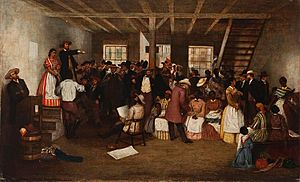
Parts of the Randolph's Tuckahoe plantation were divided into smaller sections and sold. If a sale was completed, enslaved people were often put up for sale too.
The nearby city of Richmond was the largest place for selling enslaved people in Virginia. When enslaved people were sold, their families and communities were often broken apart. It was common for people to be separated from their spouses and children, sometimes forever. They were taken from the plantation and held in jails or special pens by slave traders. They could be there for weeks and might be physically examined. When they were auctioned, they might be sold to another trader or sent to work on plantations in the Deep South.
Runaways
A carpenter named Gabriel, or Gabe, ran away from Tuckahoe on December 10, 1783. Thomas M. Randolph offered a reward of $20 for Gabriel and $5 for the horse he took. Another enslaved man, Bob Christian, ran away on January 5, 1836. He had family in nearby counties and in Richmond. Tuckahoe's owner, E.L. Wight, offered $20 for his return. In 1851, Wallace Smith was sold to Joseph Allen of Tuckahoe. Smith ran away, and a reward of $200 was offered for his return.
Freedom and Its Challenges
Slavery continued in the United States until the 13th Amendment was passed in 1865. This amendment officially ended slavery. After the Emancipation Proclamation and the end of the American Civil War, laws and practices were put in place that limited the rights and opportunities for African Americans.
Some of the people who were freed after the Civil War continued to live at Tuckahoe into the early 1900s. They were paid a salary and lived in the same quarters they had before.
Others, like Levi Ellis, moved to communities of Black people. Once free, Black people in Virginia competed with white people for work in their trades. Many freedmen worked for several customers instead of being tied to one employer. This helped them avoid a relationship where they were controlled by one person.
Tuckahoe's Legacy Today
In February 2019, a group of women painted a message on a sign and pillar at Tuckahoe. The message said, "we profit off slavery." The anonymous group said this was a reminder of "Virginia's troubled history." This happened during a time when people were protesting at the Virginia State Capitol and calling for the governor to resign.
Images for kids
-
Lefevre James Cranstone, Slave Auction, Virginia




